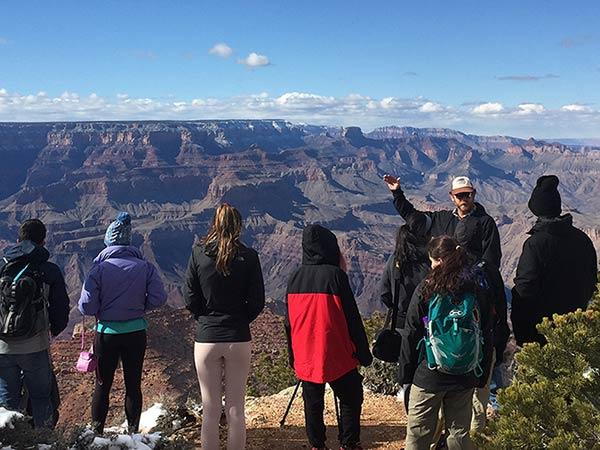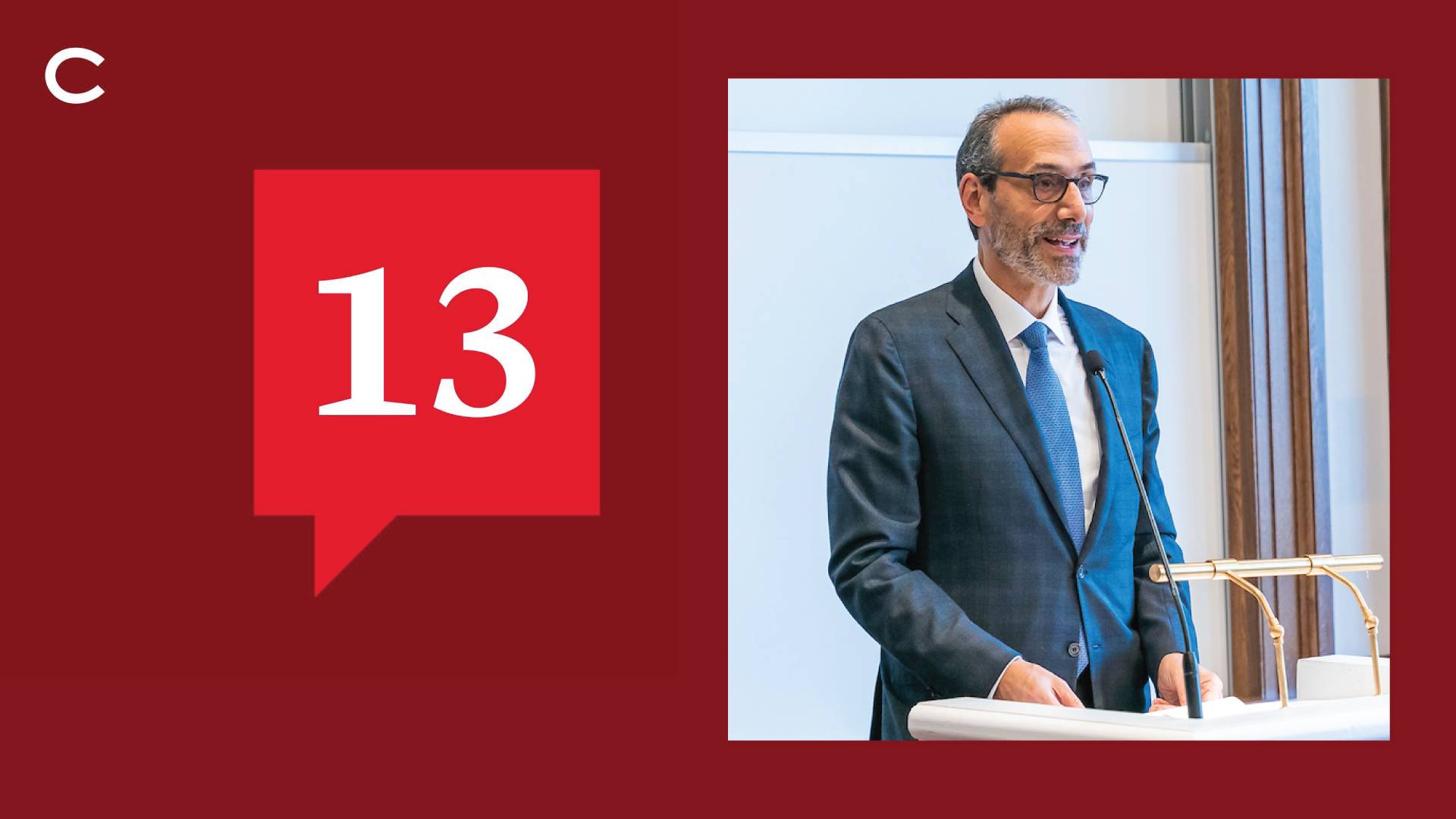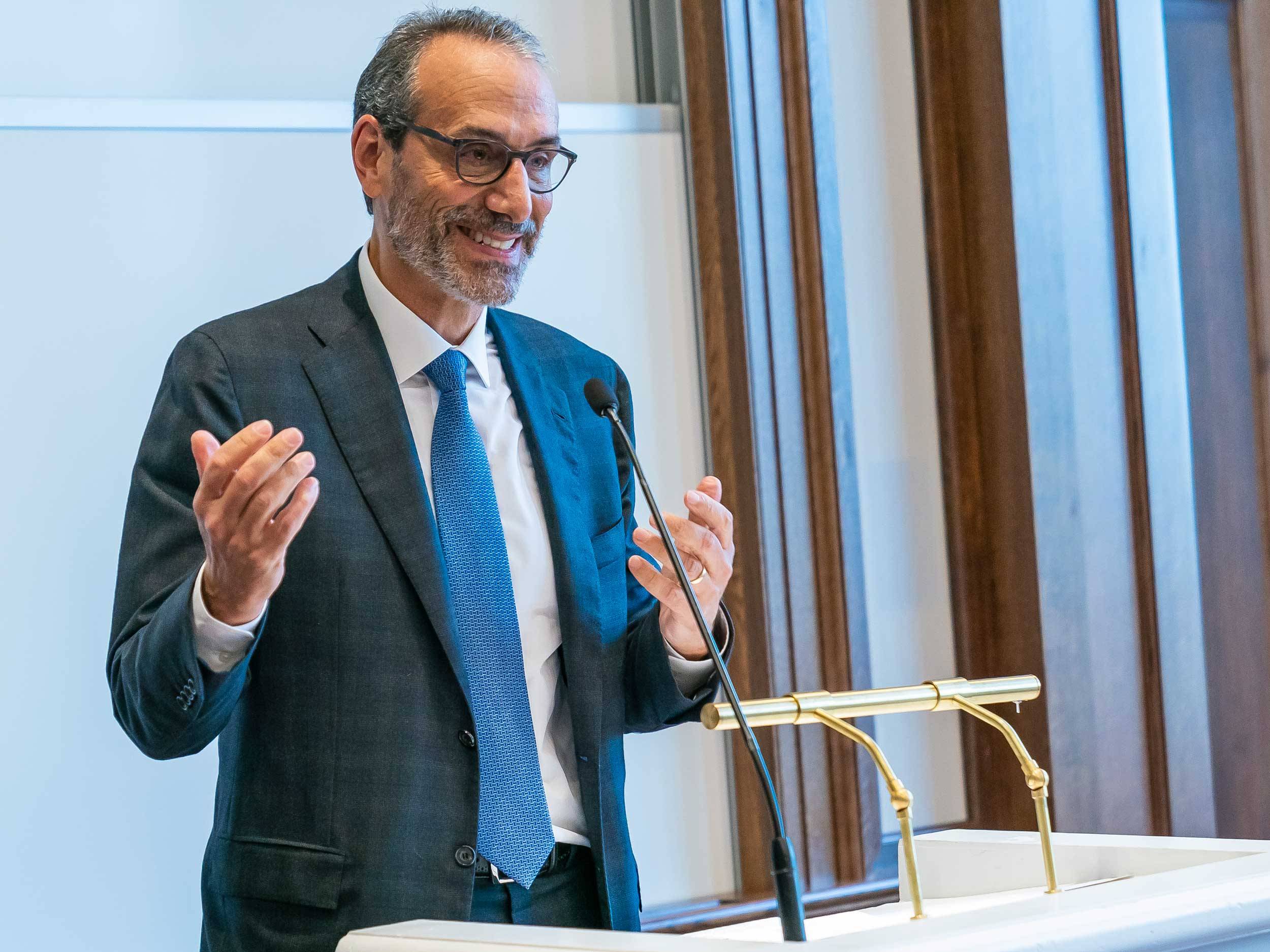The central point of what we're doing in the Middle Campus is creativity and innovation.
Dan Benton is one of the top technology investors of his generation. He graduated magna cum laude and Phi Beta Kappa from Colgate University in 1980 with a BA in Mathematics, and has served on the Board of Trustees since 2001. His generosity has allowed the developments of some of Colgate's signature programs, from the Benton Scholars to the Middle Campus development project.
Dan Benton is one of the top technology investors of his generation. He founded Andor Capital
Management in 2001, serving as CEO until closing the fund in 2016. Now, he manages Benton
Capital Management, a private family office.
Benton graduated magna cum laude and Phi Beta Kappa from Colgate University in 1980 with a BA
in Mathematics. In 2010, Colgate granted him an honorary LHD. He earned his MBA from Harvard
University in 1984.
In 1984, Benton began his career as a securities analyst in the Investment Research department at
Goldman Sachs. He was the top-ranked computer industry analyst on Wall Street from 1988-1993.
Benton joined Dawson Samberg Capital Management in 1993 as a technology analyst and portfolio
manager. Benton served as President of Pequot Capital Management (the successor firm to Dawson
Samberg) from 1999-2001 where he managed the firm’s public market technology funds and staff.
During his tenure at Dawson Samberg/Pequot (1993-2001), hedge fund assets grew from $300m to
$15b.
In the aftermath of the September 11, 2001 attacks, Benton and his partners created the Andor
Capital Management Foundation (ACMF). While the original mission of the ACMF was to provide aid
to the survivors of the tragedy, it expanded to helping members of the US Armed Forces and their
families, as well as supporting the educational and health needs of the underprivileged. During its
tenure, the ACMF disbursed $42 million in grants.
Benton has served on the board of Colgate University since 2001. He is the largest benefactor in
school history. Benton Hall houses the Center for Career Services, while the Benton Center for
Creativity and Innovation will become the hub for interdepartmental collaboration and
experimentation.
Benton also serves on the Boards and Executive Committees of The Hospital for Special Surgery,
and Horace Mann School. He is a past trustee of The Whitney Museum, Memorial Sloan Kettering
Cancer Center, Khan Academy (where he sits on the Global Advisory Board), and Northern
Westchester Hospital.
Dan enjoys traveling, spending time with his five children, crossword puzzles, politics,
Pilates, and playing golf. He lives in NYC and Katonah, NY with his wife, Stephanie March, and their
Maine Coon, TacoCat.
In His Own Words
Benton recently sat down with Colgate's 13 podcast to discuss his time at Colgate, his investment career, and his commitment to the Arts, Creativity, and Innovation initiative. Listen to the full episode here.
Arts, Creativity, and Innovation with Dan Benton ’80
The following Q+A with Dan Benton was adapted from a recent episode of Colgate’s bi-weekly podcast, 13. Listen to the full episode here.
This year, Colgate University announced a new $25 million gift from Dan Benton in support of Colgate's plan for arts, creativity, and innovation, along with other elements of the Third-Century Plan.
Mr. Benton graduated from Colgate in the class of 1980, and he began his career as a securities analyst in the investment research department at Goldman Sachs from 1984 to 1993. He was the top-ranked computer industry analyst on Wall Street from 1988 to 1993. And, Mr. Benton joined Dawson Sandberg capital management in 1993 as a technology analyst and portfolio manager. Dan served as president of Pequot Capital Management, the successor firm to Dawson Sandberg from 1999 to 2001 where he managed the firm’s public market technology funds and staff during his tenure at Dawson Sandberg slash equate. The hedge fund’s assets increased from 300 million to $15 billion.
In 2001, Mr. Benton founded Andor Capital Management, serving as CEO until closing the fund in 2016 and becoming a private family office investor, Mr. Benton received his MBA from Harvard University and his bachelor's from Colgate. He serves on the boards of Colgate University, the Hospital of Special Surgery, and the Horace Mann school. He is a past trustee of the Whitney Museum, Memorial Sloan Kettering Cancer Center, Khan Academy, and Northern Westchester Hospital.
Q: I'm curious about your time at Colgate and any activities clubs you were involved in. I think you were a mathematics major?
A: I was, indeed. I was kind of a nerd at Colgate. I started in 1976, and the school had only recently gone co-ed at that point. I stayed in an all-male dorm because I thought there would be serious people there, and it turned out that it was half-serious people and half very unserious people. But that led to a pretty narrow social life for a while.
I gravitated to math and science classes but I tell you the thing that I value most about my Colgate experience in education was really being exposed to the liberal arts. You know, I mean, I took a lot of math, and math, I think, really helps you formulate the way you think and it helps you solve problems. It tells you that there are right and wrong answers, unlike economics, which,you know, you're always supposed to assume the answer.
I took four political science classes and I took four art history and architecture classes. Um, you know, I took science classes. I took a class in French literature and French. I mean, these were magnificent experiences to me. And if you look at how my life developed, you know, I'm incredibly involved in politics right now, I'm trying to figure out a way to solidify the center.
I've been on art museum boards, I've been a hospital museum boards. You know, it's just made me a more interesting and broader person.
Q: Were there any professors that may have had a profound impact on you and your ultimate career path?
A: Not necessarily my direct career path, but Dan Racino was just a marvelous math professor. He really turned higher-level math into fun. It was like doing puzzles. I took abstract algebra with him and number theory. I mean, it was delightful. I just would love to go to class.
Q: Running an investment firm requires a bit of a knack for spotting trends long before they have an impact on the market. How do you look for the next big thing?
A: I told my wife that my superpower is predicting the future. It's a lot of what investing is, is pattern recognition and seeing what's happened in the past and seeing how companies have evolved in the past, how trends evolve... and saying, ‘okay, what's different about this one.’
I think that has made me a successful investor. You know, if you look at the computer industry, the history of the computer industry, with the growth of PC companies. It was Apple at the time, it was Compaq, and Dell. IBM couldn't compete in that business, even though they had a PC, for a whole host of reasons. Most of it being that they were the mainframe incumbent and PC sales hurt mainframe. Well, it's the same thing now in cars. You know, there's a reason why Tesla has a huge, huge advantage in electric cars right now... the existing incumbent companies (Ford, GM, et cetera) it's very difficult for them to move into a business that they're just not as good at.
Q: When you were at Andor Capital, what was the firm most known for and what were you most proud of during your time at the helm of that company?
A: So, Andor was a technology focused hedge fund. It came from my background at Goldman. I focused only on technology at Dawson Sandberg and at Pequot we built out a very big technology team. And at the time we were the biggest long, short hedge fund with around $10 billion in assets, and actually 15 at the peak, and that is tiny by comparison to today's hedge funds.
But, at the time, in 2000 it was pretty big. That's really what we were most proud of, was building such a giant organization with 300 people at the peak. Then, you know, the challenge, as it turns out in hindsight, was scaling it into a sustainable business. A lot of hedge funds are dominated by one or two people at the top who are the portfolio managers that develop a track record. And it's very difficult to transition that to a next-generation when you get tired, and every, and everybody in the hedge fund industry gets tired. That was our goal, and unfortunately just like everyone else, we weren't able to achieve that.
Q: Your new gift to Colgate will create the Benton Center for Creativity and Innovation, the anchor building of a 36,800 square foot complex on Colgate's middle campus to house, computer science, film, and media studies, theater, and dance. What do you find exciting about this space and what inspired you to donate to this initiative in particular?
A: I was talking in the beginning about how my breadth of exposure really made me a better person. I'm a strong, strong advocate for the liberal arts, and, I talk to the Benton scholars once a year. We all read a book together and we share our thoughts, but in the beginning, I go around and ask everyone to introduce themselves. And these are first-year students, and they tell me what they're planning, And I can't tell you the number of double majors that I hear. And I just put my head in my hands. The value of a place like Colgate is that you can be exposed to many, many different things. As Steve Jobs said, the marriage of technology and arts is what makes our hearts sing.
When Lesleigh [Cushing] first told me about this idea of moving, um, computer science, um, and film and media studies into the middle campus, surrounded by the rest of the performing and fine arts, you had me at hello.
Q: Tell us about the Daniel C. Benton '80 Endowed Chair in Arts, Creativity, and Innovation
A: When I have given the Colgate in the past, and continue to do so, my goal, in general, is to set an example as to something that I think is really important. And I hope other people will follow. Specifically with the chairs. Colgate, as an institution, compared to its peer schools does not have enough endowed professorships. When that was pointed out, specifically with the third-century plan area that we want to focus on, it was a way for me to, early on in the process, to make an endorsement of that part of the plan, and hopefully, to inspire others to [donate]. There is a respectful amount of distance between what a giver does and what the university does particularly in the area of pedagogy. So, I have no influence whatsoever on who sits in the chair.
Q: One of your previous gifts to Colgate went toward the construction of what is now known as Benton Hall, the home of career services at Colgate. That building has won national design awards for its masonry and energy efficiency. When you give to a project like that, how involved are you in the planning and the design of the end product?
A: Brian Casey, our phenomenal president, has a background in architecture and he's very interested in how things look, and he introduced the campus to a firm called Robert AM Stern Architects. It was their first building on campus with Benton Hall, followed by the two new dorms, Burke and Pinchin, up by the Coop. You can see how thoughtful they are in how those buildings all look like they'd been there forever.
They had never been on campus before, and when they visited they strolled around the campus and toured a lot of buildings and decided what they liked, and what they didn’t like. So, what they really liked, and that's why there's an archway [on Benton Hall], because they really liked the arch on Haskell Hall, and they liked the sandstone on James B Colgate Hall. They also liked the open ceiling of James C. Colgate Hall, the old student union. My response to those things were, you know, I don't really love the arch, but fine. Sandstone, I mean, nobody goes to the admission building to do work, or, I mean, obviously the administration does, but it's not an academic building. And frankly, the student union is a building that is underutilized on the campus. And, by the way, do we really want a feeling of a career center that looks like a German beer hall? So I made a couple of observations on that. I also helped get the air blower things out of the restrooms. I had them replaced with paper towel dispensers because boy, I don't like hand dryers.
Q: Where do you see the space of higher education changing or evolving in the next 10 years?
A: I think that the liberal arts has been on the defensive these last few years, maybe longer than that, in terms of, you know, what's the use of a liberal arts education. And we do see a trend towards students going to programs where Colgate doesn't offer a finance degree. We don't have an engineering school. And I think a lot of students, perhaps driven by their parents, are headed in that direction because they want outcomes. They want to think their kid's going to get a job after school. So look, that's one of the reasons why we have the Benton Hall career center. You know, that was very important to me that we do prove that, uh, that Colgate students generate positive outcomes, uh, that Colgate that Colgate, you know, prepares them for more things in their life.
That's great, but I also think that the central point of what we're doing in the middle campus is creativity and innovation. Creativity is imagination. It's ideas. Innovation is the implementation of those ideas. How do you make this happen? It's creative to come up with the idea of a rocket that's going to land itself, and where the first stage can land and be reused. No one's ever done that before. That's creatives making it work. The person does it. Now that's an innovation like When I look at the programs that we're putting together in the middle campus, and I think about this, I think about the video game industry.
Let's think about virtual reality. What is that? Well, it has a script, it has art, it has music, it has animation, it has a story, oh, and it has programmers that write this thing. And, they all get to be involved in the creative process and the innovation process. That to me is really what the liberal arts is all about.
Q: Your most recent gift makes you the single largest in Colgate history, surpassing University namesake James B Colgate. Can you remember what your first gift to Colgate was, and what spurred you to give at that time?
A: I grew up in a family that was an upper middle-class family. My father was a psychiatrist, and an artist. What I remember from being a young kid is listening to the WBAI, which is a version of national public radio today, and their droning telethons. And they would give, you know, but year after year, they would send in their $10 or $20, and then they would get their tote bag. That made an impression on me. And when I graduated from college, I started what is now a 41 year streak of giving to Colgate every single year. And I don't remember what that first gift was, and maybe it was ten bucks, maybe with 25 bucks, but it has been something I'm proud of, it’s something I'm very proud of.





